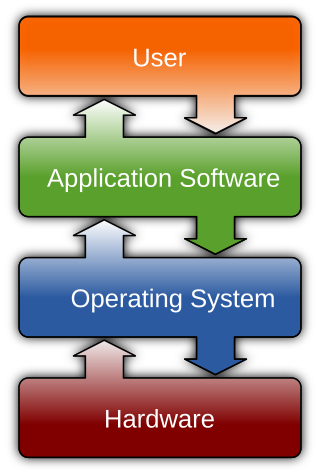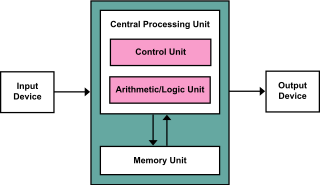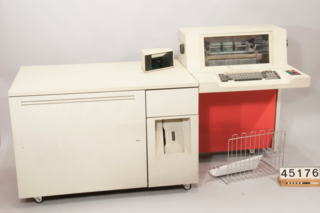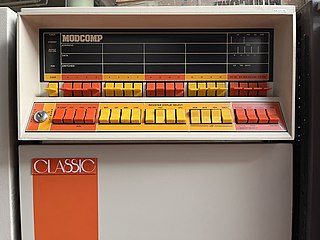Related Research Articles

In mathematics and computer science, an algorithm is a finite sequence of rigorous instructions, typically used to solve a class of specific problems or to perform a computation. Algorithms are used as specifications for performing calculations and data processing. More advanced algorithms can use conditionals to divert the code execution through various routes and deduce valid inferences, achieving automation eventually. Using human characteristics as descriptors of machines in metaphorical ways was already practiced by Alan Turing with terms such as "memory", "search" and "stimulus".

Alan Mathison Turing was an English mathematician, computer scientist, logician, cryptanalyst, philosopher and theoretical biologist. Turing was highly influential in the development of theoretical computer science, providing a formalisation of the concepts of algorithm and computation with the Turing machine, which can be considered a model of a general-purpose computer. He is widely considered to be the father of theoretical computer science and artificial intelligence.

Software is a collection of programs and data that tell a computer how to perform specific tasks. Software often includes associated software documentation. This is in contrast to hardware, from which the system is built and which actually performs the work.

A computer program is a sequence or set of instructions in a programming language for a computer to execute. It is one component of software, which also includes documentation and other intangible components.

A Java virtual machine (JVM) is a virtual machine that enables a computer to run Java programs as well as programs written in other languages that are also compiled to Java bytecode. The JVM is detailed by a specification that formally describes what is required in a JVM implementation. Having a specification ensures interoperability of Java programs across different implementations so that program authors using the Java Development Kit (JDK) need not worry about idiosyncrasies of the underlying hardware platform.
In processor design, microcode serves as an intermediary layer situated between the central processing unit (CPU) hardware and the programmer-visible instruction set architecture of a computer, also known as its machine code. It consists of a set of hardware-level instructions that implement the higher-level machine code instructions or control internal finite-state machine sequencing in many digital processing components. While microcode is utilized in general-purpose CPUs in contemporary desktops, it also functions as a fallback path for scenarios that the faster hardwired control unit is unable to manage.

A programming language is a system of notation for writing computer programs.

A Turing machine is a mathematical model of computation describing an abstract machine that manipulates symbols on a strip of tape according to a table of rules. Despite the model's simplicity, it is capable of implementing any computer algorithm.
In computability theory, a system of data-manipulation rules is said to be Turing-complete or computationally universal if it can be used to simulate any Turing machine. This means that this system is able to recognize or decide other data-manipulation rule sets. Turing completeness is used as a way to express the power of such a data-manipulation rule set. Virtually all programming languages today are Turing-complete.

In computer science, an interpreter is a computer program that directly executes instructions written in a programming or scripting language, without requiring them previously to have been compiled into a machine language program. An interpreter generally uses one of the following strategies for program execution:
- Parse the source code and perform its behavior directly;
- Translate source code into some efficient intermediate representation or object code and immediately execute that;
- Explicitly execute stored precompiled bytecode made by a compiler and matched with the interpreter Virtual Machine.
The 801 was an experimental central processing unit (CPU) design developed by IBM during the 1970s. It is considered to be the first modern RISC design, relying on processor registers for all computations and eliminating the many variant addressing modes found in CISC designs. Originally developed as the processor for a telephone switch, it was later used as the basis for a minicomputer and a number of products for their mainframe line. The initial design was a 24-bit processor; that was soon replaced by 32-bit implementations of the same concepts and the original 24-bit 801 was used only into the early 1980s.
In computer science, a universal Turing machine (UTM) is a Turing machine capable of computing any computable sequence, as described by Alan Turing in his seminal paper "On Computable Numbers, with an Application to the Entscheidungsproblem". Common sense might say that a universal machine is impossible, but Turing proves that it is possible. He suggested that we may compare a man in the process of computing a real number to a machine which is only capable of a finite number of conditions q 1: q 2. .... qI; which will be called "m-configurations". He then described the operation of such machine, as described below, and argued:
It is my contention that these operations include all those which are used in the computation of a number.

The IBM 650 Magnetic Drum Data-Processing Machine is an early digital computer produced by IBM in the mid-1950s. It was the first mass produced computer in the world. Almost 2,000 systems were produced, the last in 1962, and it was the first computer to make a meaningful profit. The first one was installed in late 1954 and it was the most-popular computer of the 1950s.

The von Neumann architecture—also known as the von Neumann model or Princeton architecture—is a computer architecture based on a 1945 description by John von Neumann, and by others, in the First Draft of a Report on the EDVAC. The document describes a design architecture for an electronic digital computer with these components:

The IBM System/32 introduced in January 1975 was a midrange computer with built-in display screen, disk drives, printer, and database report software. It was used primarily by small to midsize businesses for accounting applications. RPG II was the primary programming language for the machine.
TACL is the scripting programming language which acts as the shell in Tandem Computers/NonStop computers.

Modcomp, Inc., originally Modular Computer Systems, was a small minicomputer vendor that specialized in real-time applications. They were founded in 1970 in Fort Lauderdale, Florida. In the 1970s and 1980s, they produced a line of 16 and 32-bit mini-computers. Through the 1980s, Modcomp lost market share as more powerful micro-computers became popular, and Digital Equipment Corporation's VAX and Alpha systems continued to grow. The company successfully survives today as a systems integrator operating as CSPi Technology Solutions headquartered in Deerfield Beach, Florida.
The philosophy of artificial intelligence is a branch of the philosophy of mind and the philosophy of computer science that explores artificial intelligence and its implications for knowledge and understanding of intelligence, ethics, consciousness, epistemology, and free will. Furthermore, the technology is concerned with the creation of artificial animals or artificial people so the discipline is of considerable interest to philosophers. These factors contributed to the emergence of the philosophy of artificial intelligence.

The history of computer science began long before the modern discipline of computer science, usually appearing in forms like mathematics or physics. Developments in previous centuries alluded to the discipline that we now know as computer science. This progression, from mechanical inventions and mathematical theories towards modern computer concepts and machines, led to the development of a major academic field, massive technological advancement across the Western world, and the basis of a massive worldwide trade and culture.

A computer is a machine that can be programmed to carry out sequences of arithmetic or logical operations (computation) automatically. Modern digital electronic computers can perform generic sets of operations known as programs. These programs enable computers to perform a wide range of tasks. The term computer system may refer to a nominally complete computer that includes the hardware, operating system, software, and peripheral equipment needed and used for full operation; or to a group of computers that are linked and function together, such as a computer network or computer cluster.
References
- ↑ "Så fungerar Genetix Archived 2011-10-08 at the Wayback Machine " (In Swedish) Computer Sweden 9 October 2006. Retrieved 27 July 2009.
- ↑ Mark Ward. "From little acorns… mighty software can be grown" (archived), New Scientist , 15 November 1997.
- ↑ "Han vill erövra världen" (In Swedish) Computer Sweden 9 October 2006. Retrieved 27 July 2009.
- 1 2 3 Stefan Dubowski. "It's time for change", IT World Canada , 26 May 2005